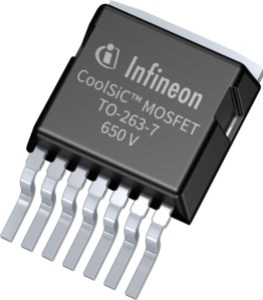Infinitum and Infineon Technologies AG have recently entered a strategic technology collaboration, leveraging Infineon’s silicon carbide (SiC) solutions for Infinitum’s smart industrial electric motors. For Infinitum, the collaboration solidifies production of its sustainable and high-efficiency Aircore EC motors. Both companies bring a wealth of knowledge and substantial experience in SiC technology.
Electric motors are estimated to consume from 45% to 53% of the world’s electricity, according to industry estimates. In excess of 800-million motors are sold annually and the numbers are rising. The collaboration will make a dent in those numbers by helping to increase the energy efficiency of the electric motors.
The joint effort is focused on embedding Infineon’s SiC solutions into Infinitum’s smart industrial electric motors that are finding their way into the most rigorous applications including HVAC fans, pumps, commercial electric vehicles and materials handling equipment.
Infinitum’s Aircore motor design eliminates heavy iron used in traditional motors, replacing it with a lightweight, printed circuit board (PCB). The motors are 50% smaller and lighter, 10% more efficient and use 66% less copper compared with traditional motors, according to the company. The precise motor control is claimed to save upwards of 65% of energy use depending on the application.
Aircore EC features a unique, integrated variable frequency drive (VFD) that takes advantage of SiC and other embedded technologies, resulting in more precise motor control, optimal power and energy savings. Designed and manufactured with a sustainable, circular lifecycle, the motor’s modular architecture allows the housing, rotors and stators to be reused multiple times, giving parts a second and third life, keeping the motor in service and out of landfills.
Infineon SiC solutions
Infineon’s first SiC chip was introduced over 20 years ago. Infineon’s CoolSiC semiconductors provide better efficiency, size and cost when compared to silicon-based solutions. The use of SiC technology brings power switching at voltages of 650 V and above for a variety of applications that deal with high temperatures and harsh environments — parameters that Infinitum targets.
Under the collaboration, the CoolSiC technology and Infineon’s motor control expertise will be used to help Infinitum achieve energy efficiency and control improvements over standard induction motors. CoolSiC 1200-V SiC Trench MOSFETs, for example, are built on a state-of-the-art trench semiconductor process that is optimized to deliver both the lowest losses and the highest reliability in operation.

The 650-V CoolSiC MOSFETs in a D²PAK with .XT interconnection technology offer improved switching behavior at higher currents and lower reverse recovery charge and drain-source charge than silicon. (Source: Infineon Technologies AG)
CoolSiC MOSFET advantages also include the lowest gate charge and device capacitance levels available in SiC switches, no reverse recovery losses of the anti-parallel diode, temperature-independent low switching losses, and threshold-free on-state characteristics. The advantages also include superior gate-oxide reliability enabled by a trench design, best-in-class switching and conduction losses, highest transconductance level (gain), a threshold voltage of Vth = 4 V and short-circuit robustness.
CoolSiC benefits include longer life, high efficiency for reduced cooling effort, reduced system complexity and cost, higher frequency operation, increased power density and ease of design and implementation. SiC MOSFET technology delivers the highest-level efficiency at high switching frequencies allowing for system size reduction, power density increases, and high lifetime reliability, according to Infineon.
Applications for CoolSiC devices in addition to servo and motor drives, include photovoltaic inverters, battery charging and formation, server and telecom power, energy storage and UPS, industrial SMPes and auxiliary power supplies.
Why the collaboration makes sense
Until the last decade, SiC was an exotic material for semiconductors. Today, SiC is essential to power electronics in part because of their inherent characteristics and because of the limitations of silicon. Silicon balks when used in higher temperatures, voltages and frequencies.
SiC has 10× the breakdown electric field strength and 3× the bandgap than silicon and it enables a wider range of p- and n-type control required for device construction. SiC also is cooled easier and faster than silicon, and it features low thermal expansion and excellent thermal shock resistance.
SiC will become dominant for power devices with voltage ratings in excess 600 V that require wider temperature ranges, thermal conductivity, lower switching losses and increased switching frequencies. Another important factor involves drift layer thickness, which can be reduced using SiC, allowing for smaller components. The thickness strongly influences a MOSFET’s on-resistance and SiC enables MOSFETs with lower ohmic losses, improving efficiency.
Infineon’s SiC MOSFETs are rugged and suited for harsh environments, a key material for industrial applications and electric vehicles.
Existing SiC expertise from both companies will be central to bringing next-generation energy-efficient motors and motor control to market.
Advertisement
Learn more about Infineon Technologies






